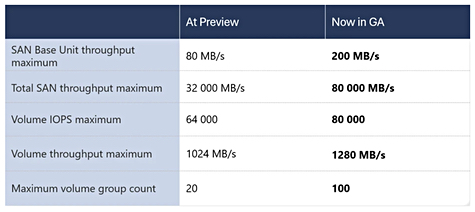Microsoft has announced general availability of its iSCSI-based Azure Elastic SAN, facilitating the migration of on-premises SANs to its public cloud.
The Azure Elastic SAN was previewed way back in October 2022. It had independent compute and capacity scaling, and single volume performance of up to 64,000 IOPS and 1,024 MBps bandwidth. The GA version goes up to 80,000 IOPS and 1,280 MBps and there are other capacity and throughput improvements.
Azure Storage GM Aung Oo writes: “Azure Elastic SAN responds to the vital need for seamless migration of extensive SAN environments to the cloud, bringing a new level of efficiency and ease.”

Added features since the preview version announcement include:
- Shared volume support enabling the migration of cluster applications, such as SQL Failover Instances, to Elastic SAN.
- Control of an application’s data consumption with Server-Side Encryption with customer-managed keys.
- Client volume access control with private endpoint support.
- Snapshot support with snapshot export publicly available.
- Azure Monitor Metrics to measure performance and capacity.
- Azure Policy to help with Elastic SAN configuration.
Workload suitability
Elastic SAN storage can be shared across Azure workloads. Previously migrating an on-premises SAN and its set of workloads to Azure meant configuring individual disks. Now users can provision at the Elastic SAN resource level, across volumes, and managing security policies at the workload level.
Azure has partnered with Cirrus Data Solutions to make its Cirrus Migrate Cloud available in the Azure marketplace. Cirrus Migrate Cloud has a cost-optimization wizard. Cirrus Data Solutions CEO and chairman Wayne Lam said: “Over the last 18 months, we have worked closely with the Azure team to develop enhanced functionality in Cirrus Migrate Cloud that enables enterprises to move their live workloads to Azure Elastic SAN with just a click.”
The Cirrus migration wizard covers Azure’s Disk block storage as well as Elastic SAN and it will recommend the appropriate block storage option for any particular workload.
Elastic SAN can also be used to as the backing store for Azure Container Storage, with the ACS cluster capable of being spun down and the data persisted in Elastic SAN. Aung Oo suggests using Elastic SAN for containerized general purpose database workloads, streaming and messaging services, or in continuous integration and continuous delivery (CI/CD) environments.
Value and pricing
Users can now expand their Azure VMware Solution (AVS) storage capacity without having to add more vSAN storage nodes. Instead they can deploy and present an Elastic SAN volume through the Azure Portal as an external data store to the AVS cluster.
You can avoid over-provisioning of SQL Server deployments on Azure Virtual Machines (VMs) to reach a target VM-level disk throughput by using Elastic SAN. Peter van Noort, Cloud Engineer, de Goudse verzekeringen and Michiel Kuip, SQL Server DBA, de Goudse verzekeringen, said: “The Elastic SAN performance allowed us to reduce the VM size and implement constrained cores to save substantial costs on SQL server core licensing.”
A Microsoft example envisages a customer with three databases running on Azure and each requiring a set number of IOPS:
- MySQL – 30,000 IOPS
- PostgreSQL – 20,000
- Oracle – 50,000
These IOPS sum to 100,000 and that’s what a user would have to provision before Elastic SAN. With Elastic SAN, the provisioned volumes can share the total performance provisioned at the SAN level. This means that Elastic SAN provisioned for 50,000 IOPS can support these three workloads and the user saves 50,000 IOPS provisioning by moving them to Elastic SAN.
Elastic SAN pricing can be found here. It is provisioned by base and capacity units according to need. The base unit capacity provides 1 TiB, 5,000 IOPS and 200 MBps/Tib throughput and costs $0.08/GiB/month or $81.92 per unit/month.
A capacity-only unit with 1 TiB, no IOPS or MBps costs $0.06/GiB/month or $61.44 per unit/month. Altogether, Aung Oo claims this is “the lowest per GiB cost available for AVS storage.”
Availability
Elastic SAN is available in these regions:
- France Central – LRS & ZRS
- Southeast Asia – LRS
- Australia East – LRS
- North Europe – LRS & ZRS
- West Europe – LRS & ZRS
- UK South – LRS
- East US – LRS
- South Central US – LRS
- East US 2 – LRS
- West US 2 – LRS & ZRS
- West US 3 – LRS
- Sweden Central – LRS
LRS (Locally Redundant Storage) and ZRS (Zone-Redundant Storage) are data redundancy types. LRS has three copies of each SAN in an Azure storage cluster while ZRS has three copies in different availability zones.
Get more information here.
Comment
Should you move your on-premises SAN workloads to Azure Elastic SAN? Apart from the complexity of trying to compare costs and performance (IOPS, throughput) of a Dell, HPE, IBM, NetApp, and Pure SAN, there is the point that they have public cloud instances of their block storage, such as Pure’s Azure Cloud Block Store and NetApp’s Cloud Volumes ONTAP for Azure. These offer hybrid on-premises/public cloud integration and workload portability whereas Azure Elastic SAN does not – until it’s available in the Azure Stack offering. They can also offer multi-public cloud support, which Elastic SAN does not.
Elastic SAN has obvious advantages for Azure devotees but for potential on-premises SAN migrations, hybrid cloud supporters, and hybrid multi-cloud supporters, its value gets progressively harder to discern.








